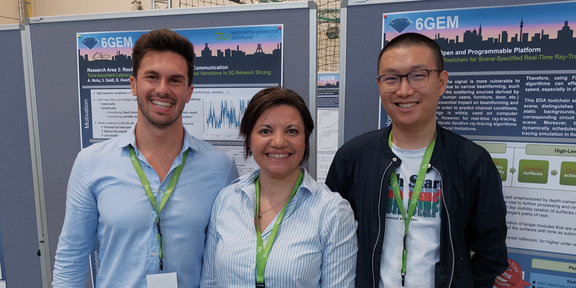6GEM General Plenary Meeting

On June 14 and 15, 2023 the 4. plenum meeting of the BMBF-funded research project 6GEM took place at TU Dortmund University. Prof. Selma Saidi and the research assistants Andrea Nota and Jintong An were present. Among others, contributions from the research area 1 open and programmable platforms, in which Jintong An is working on, and the research area 3 resilient and highly adaptive 6G communication, in which Andrea Nota is active, were presented.
One part in which research area 1 is about deals with high-level synthesis toolchain for real-time scene-specific ray tracing on FPGA. In 6G communications, the signal is more susceptible to interference from dynamic objects (e.g., people, furniture, doors, etc.) when there are changes in the environment, such as indoor areas. These objects have a significant impact on beamforming and channel conditions. To predict the channel conditions, ray tracing technology is often used on computer simulation platforms. However, this is not possible for real-time ray tracing, CPU/GPU cannot accelerate iterative ray tracing algorithms well due to their architectural limitations. Therefore, using FPGA to parallelize the iterative algorithms can improve the computation speed, especially in dynamic environments. This EDA toolchain automatically detects the target scene, distinguishes between dynamic scattering sources and static backgrounds, and compiles and sets appropriate circuit modules to match the scene. It also dynamically schedules the computation modules to adapt to real-time ray tracing simulation in the dynamic environments.
Another part of research area 3 deals with temporal latency guarantees considering channel variations in 5G network slicing. Here, different applications (called slices) are combined in a single physical network in a 5G and 6G standard scenario. In addition, wireless communication resources present a unique challenge for providing timing guarantees because they deal with highly dynamic environments where several uptime parameters are unknown. However, providing guarantees on the timing behavior of such systems remains a major challenge that must be addressed using formal analysis. In our work, we propose a sensitivity approach to determine when a new worst-case response time calculation is required. We formulate an online algorithm that can compute in real time how long the current packet latency limit is valid based on the variation of application demand and channel conditions. From an application perspective, it is a critical improvement to have a measure of how long such a boundary is stable. Depending on the duration of the current packet latency, the user device or base station can change its wireless characteristics and communication parameters accordingly to improve the overall transmission.
Here you can find more information about the 6GEM-Meeting.


